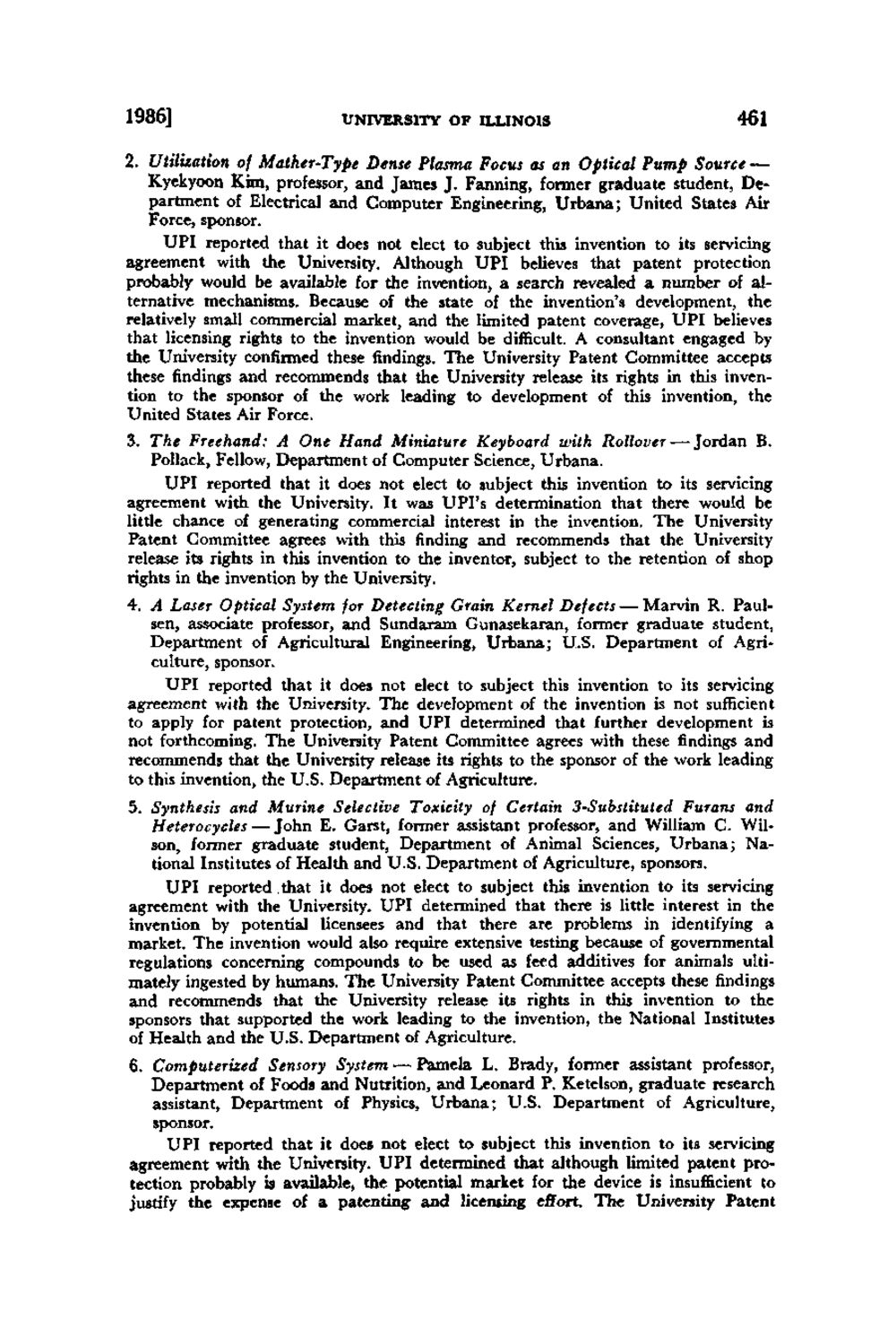| |
| |
Caption: Board of Trustees Minutes - 1986
This is a reduced-resolution page image for fast online browsing.

EXTRACTED TEXT FROM PAGE:
1986] UNIVERSITY OF ILLINOIS 461 2. Utilization of Mather-Type Dense Plasma Focus as an Optical Pump Source — Kyekyoon Kim, professor, and James J. Fanning, former graduate student, Department of Electrical and Computer Engineering, U r b a n a ; United States Air Force, sponsor. U P I reported that it does not elect to subject this invention to its servicing agreement with the University. Although U P I believes that patent protection probably would be available for the invention, a search revealed a number of alternative mechanisms. Because of the state of the invention's development, the relatively small commercial market, and the limited patent coverage, U P I believes that licensing rights to the invention would be difficult. A consultant engaged by the University confirmed these findings. The University Patent Committee accepts these findings and recommends that the University release its rights in this invention to the sponsor of the work leading to development of this invention, the United States Air Force. 3. The Freehand: A One Hand Miniature Keyboard with Rollover •— Jordan B. Pollack, Fellow, Department of Computer Science, Urbana. U P I reported that it does not elect to subject this invention to its servicing agreement with the University. It was UPI's determination that there would be little chance of generating commercial interest in the invention. The University Patent Committee agrees with this finding and recommends that the University release its rights in this invention to the inventor, subject to the retention of shop rights in the invention by the University. 4. A Laser Optical System for Detecting Grain Kernel Defects — Marvin R. Paulsen, associate professor, and Sundaram Gunasekaran, former graduate student, Department of Agricultural Engineering, Urbana; U.S. Department of Agriculture, sponsor. U P I reported that it does not elect to subject this invention to its servicing agreement with the University. The development of the invention is not sufficient to apply for patent protection, and U P I determined that further development is not forthcoming. The University Patent Committee agrees with these findings and recommends that the University release its rights to the sponsor of the work leading to this invention, the U.S. Department of Agriculture. 5. Synthesis and Murine Selective Toxicity of Certain 3-Substituted Furans and Heterocycles — John E. Garst, former assistant professor, and William C. Wilson, former graduate student, Department of Animal Sciences, Urbana; National Institutes of Health and U.S. Department of Agriculture, sponsors. U P I reported that it does not elect to subject this invention to its servicing agreement with the University. U P I determined that there is little interest in the invention by potential licensees and that there are problems in identifying a market. The invention would also require extensive testing because of governmental regulations concerning compounds to be used as feed additives for animals ultimately ingested by humans. The University Patent Committee accepts these findings and recommends that the University release its rights in this invention to the sponsors that supported the work leading to the invention, the National Institutes of Health and the U.S. Department of Agriculture. 6. Computerized Sensory System — Pamela L. Brady, former assistant professor, Department of Foods and Nutrition, and Leonard P. Ketelson, graduate research assistant, Department of Physics, Urbana; U.S. Department of Agriculture, sponsor. U P I reported that it does not elect to subject this invention to its servicing agreement with the University. U P I determined that although limited patent protection probably is available, the potential market for the device is insufficient to justify the expense of a patenting and licensing effort. The University Patent
| |